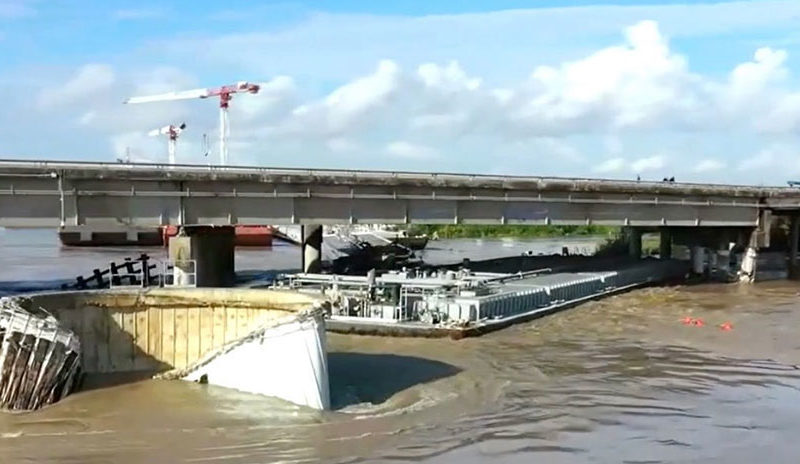
A barge breakaway that damaged a Houston-area highway bridge was the result of “extreme rise and flow of water” during a tropical storm, federal investigators determined.
Eleven barges broke free from the San Jacinto River Fleet on Sept. 19, 2019, at about 2338 during Tropical Storm Imelda, which dropped up to 30 inches of rain across Greater Houston. Six barges struck the Interstate 10 bridge over the San Jacinto River at Channelview, Texas.
National Transportation Safety Board (NTSB) investigators determined the force of the fast-moving current on the moored barges from the “historic rainfall event” caused the mooring lines to part, allowing the barges to float free.
“Contributing was the operating company not rearranging fleeting area tiers to mitigate the effect of current on barge tiers,” the report continued, referring to fleet operator Cheryl K Marine.
Attempts to reach Cheryl K Marine for comment on the NTSB findings were not successful.
The Interstate 10 bridge struck by the barges sustained more than $5.1 million in damage. Removing and repairing the six barges cost another $350,000. There was no pollution or injuries reported in the episode.
The San Jacinto River Fleet occupies more than 190 acres with seven tiers that can accommodate up to 150 barges. The fleet is located just upriver from the I-10 bridge. Barges are stored in seven tiers, or barge groupings. They are typically anchored to one another via fleeting lines and wire ropes and secured to concrete or steel anchors known as “dead men.”
At 0756 on September 19, the National Oceanic and Atmospheric Administration (NOAA) issued a flash flood warning that forecasted the San Jacinto would rise from 3.6 feet to 12.4 feet over 24 hours. Later, at 1218, after levels surged to 11 feet, NOAA revised the prediction for the San Jacinto to 15.4 feet within 24 hours.
Rising water levels in the San Jacinto came from Lake Houston, which rose steadily during the day, resulting in the uncontrolled release of water over the Lake Houston Dam, the report said. At its highest point during the storm, Lake Houston rose to 48.08 feet, which allowed 6 feet of water to flow over the spillway into the San Jacinto.
The fleet’s operations manager monitored worsening conditions in Lake Houston and the San Jacinto. At about 1530, the manager requested towboat crews working the fleet add extra mooring lines to the barges. Lightning storms prevented that from happening until about 1717, when a team from the towboat Sara K checked the fleet and added lines to the barges.
Cheryl K’s captain and crew noticed the 11 tank barges from tier 3 breaking away at about 2030. For the next 2.5 hours, several fleet towboats, including JB Bloomer, worked to control the breakaway barges and return them to the fleeting area.
“JB Bloomer attempted to push the string of six barges upriver, but the towing vessels could not hold the barges in the rising floodwaters,” the NTSB report said. “JB Bloomer’s captain maneuvered away from the barges to avoid being pinned between the barges and bridge.
“At 2337,” the report continued, “the block of six barges contacted and damaged the protective cell closest to the channel on the eastern bank and then struck and damaged the western bank protective cell.”
A damage assessment after the storm determined that the westbound span sustained damage. Three support columns on the north side of the bridge were seriously damaged. Protective cells upriver from the bridge intended to blunt impact from vessels also sustained serious damage.
Federal investigators noted efforts by Cheryl K Marine’s personnel to monitor the weather and keep customers appraised of the situation throughout the day. But they said fleet officials should have implemented its severe weather plans sooner and acted faster to reinforce vessels in the fleeting area.
“Had the longer string of barges at (tier 3) been broken down and barges more evenly distributed among the tiers, the resulting shorter strings would have been less vulnerable to swift currents,” the report said. “The forces on the barges’ mooring lines in tier 3 would have been lessened due to the lower number of barges acted on by the current.”
San Jacinto Fleet’s port captain told investigators that when severe weather approaches, the barges are usually rearranged to reduce the number of barges exposed to swifter currents. On the day of the accident, however, the captain reported that the weather changed so rapidly that they did not have a chance to remove the barges.
Investigators found no indication that Cheryl K Marine’s senior leadership followed their own severe weather procedures for Tropical Storm Imelda, the NTSB determined. No completed or signed severe weather forms, checklists, or required actions items listed in the procedures were provided to investigators to demonstrate these processes were followed.
The bridge was repaired and reopened to its original capacity by mid-February 2020, about five months after the accident.

